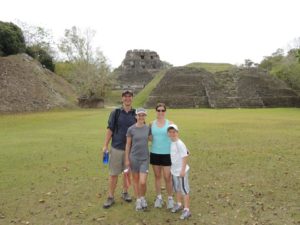I was with a birding group enroute to a Mayan ruin in northern Belize last year when our van passed through a Mennonite community. Belize is a Central American country bordering the Caribbean Sea, with a Mayan background. Belizeans have chocolate skin, eat plantains and rice, wear brightly-colored clothes, and live in purple and green dwellings. It’s a Caribbean world.
Within that laid-back and humid universe are the fully clothed guttural-speaking conservative Mennonites, most of whom shun electricity and modern technology. They wear identical outfits that cover the whole body, work industriously by farming, building, and engineering, and abide by their religious beliefs of the 19th century. Stern faces, blonde, and fair-skinned, they looked like German farmers from another century.
See also: About Belize
It happened to be a Sunday and we were way out on rural gravel roads headed for Lamanai, a Mayan ruin in the jungle. The Mennonites were also on the road, on their way to church. We had an eye-opening look at a cultural phenomenon. There were eight of us in this van and I noticed we were all gawking as numerous horse-drawn carriages passed by.
As we drove slowly along making room on the narrow road, our guide explained that there is a big Mennonite community in Belize that arrived in the late 1950s and early 60s from Mexico. Originally from Prussia and before that Germany and Holland, they settled and re-settled in many parts of the world including Canada and nearby Mexico. You can read more about their history here. We drove by their farmsteads and had many questions.
See also: Placencia Village
Of Belizean as well as Mayan descent, our guide talked warmly about the Mennonites and praised the work they have done in Belize. He said they have brought agriculture to his world, putting eggs and poultry on the table that they never had before. So many vegetables they have now, he beamed. And there was no one better, he said, for helping him fix his car and building furniture. So dependable and honest, too. He pointed to a farm tractor and explained: their religion allows rubber tires on horse drawn vehicles, but gas-powered tractors or cars have to have metal wheels.
Later that day while birdwatching in Lamanai, we encountered a Mennonite group on the trail. The men and boys walked in their own group, while the women and girls with armfuls of babies trailed behind. Of course they stared at us as much as we stared at them. We were sporting big cameras and binoculars, dressed in nylon and lycra, a group racially- and gender-mixed. We all made quiet but warm gestures in passing, giving each other respectful room on the trail and nods of acknowledgment. When they spoke amongst themselves their language sounded like German, but it is actually a combination of German and Dutch called Plautdietsch.
See also: Belize Culture
I pondered all this. Their beliefs and values were almost completely the opposite of my own. They razed the jungles to farm, and continue farming practices that are damaging to the environment. They breed strictly amongst their isolated community and at high rates, with no regard to population control. Men are superior in their world, and women are for tending the home and making more babies. But my philosophies, I realized, were beside the point.
The disparate cultures of Mayan- and German-based communities have worked together in Belize for over half a century. Over the years they have learned to accept and respect one another. This was the point. We all passed in proximity on this trail, serenaded by howler monkeys and squawking toucans overhead, all of us breathing together under one tropical canopy. If only more of the world could coordinate their differences so amicably.
Source: http://jeteliot.wordpress.com













